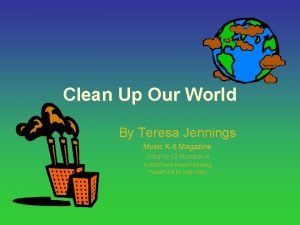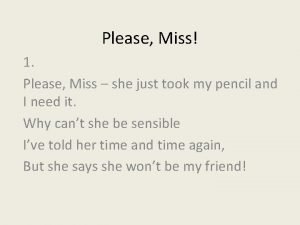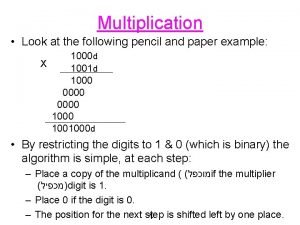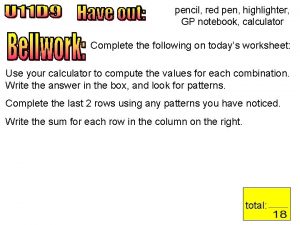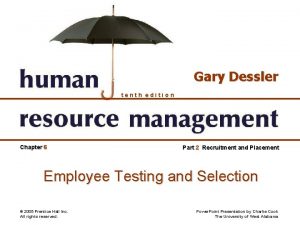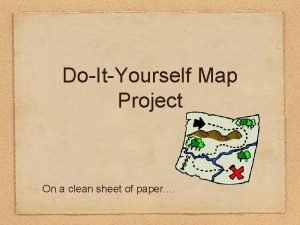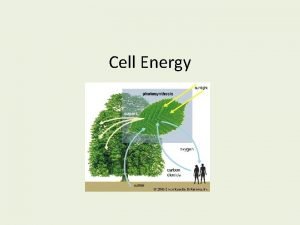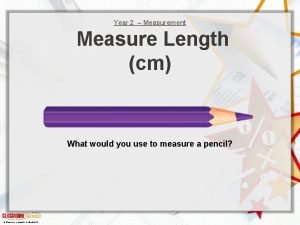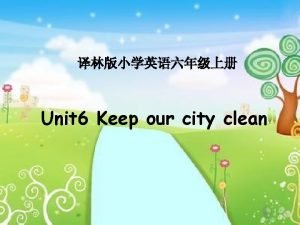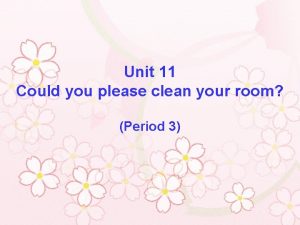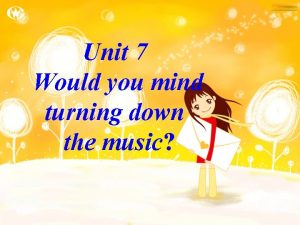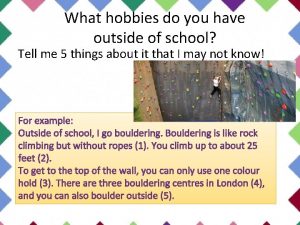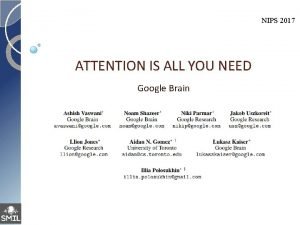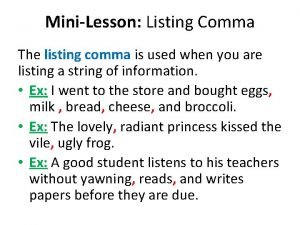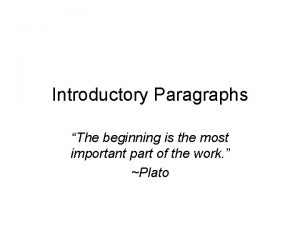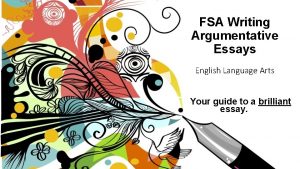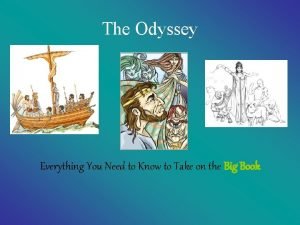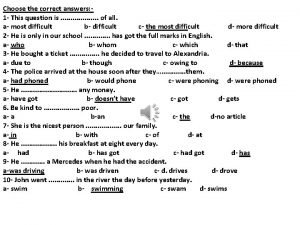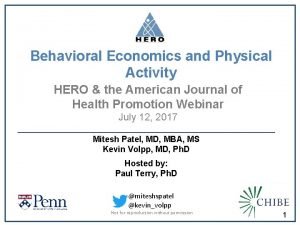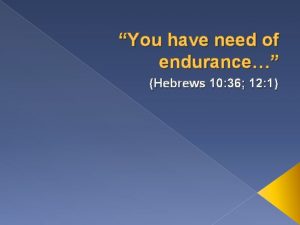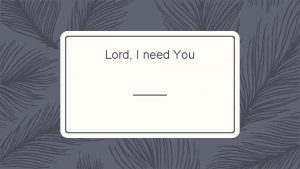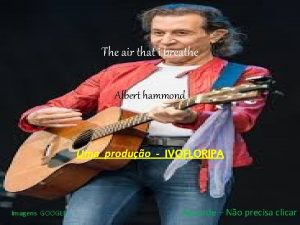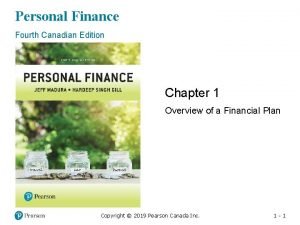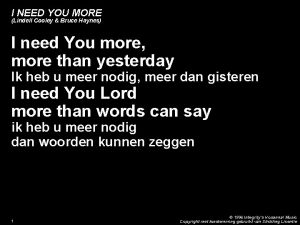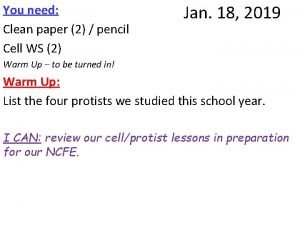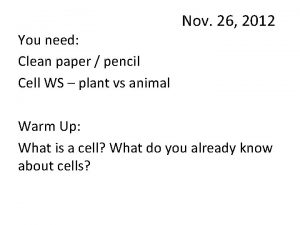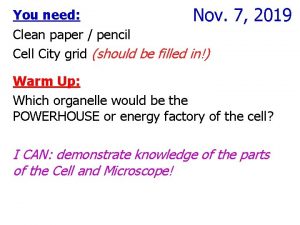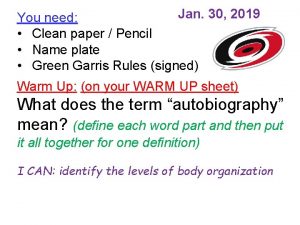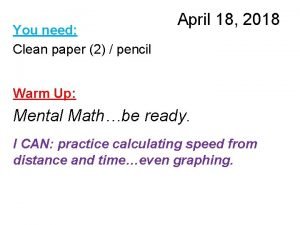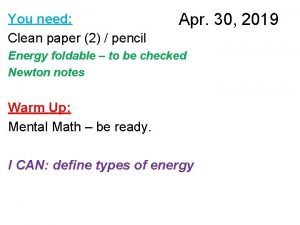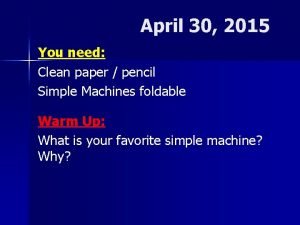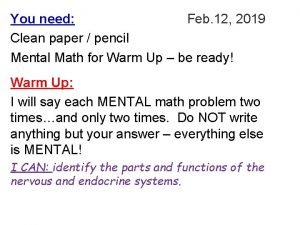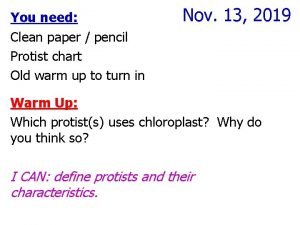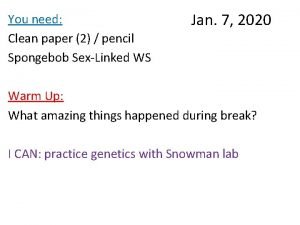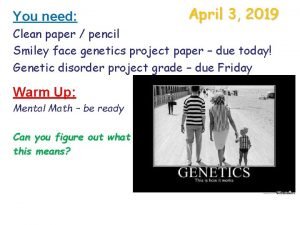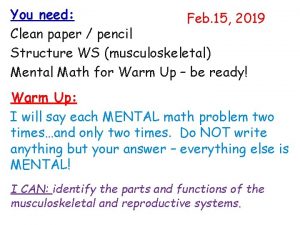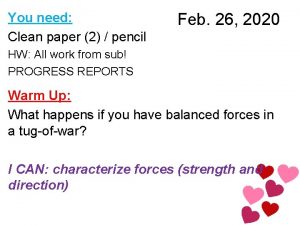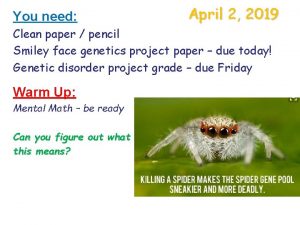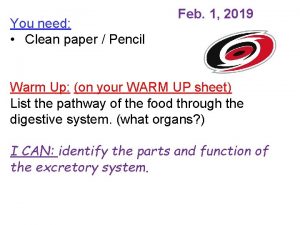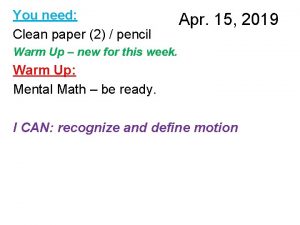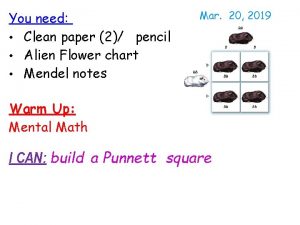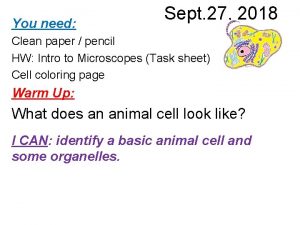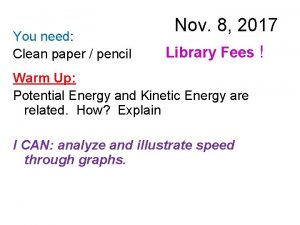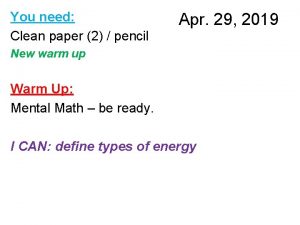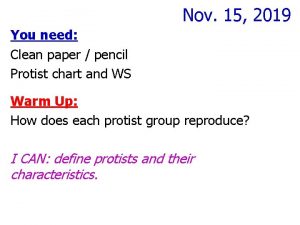You need Clean paper 2 pencil Cell WS













































- Slides: 45

You need: Clean paper (2) / pencil Cell WS (2) Test corrections? Jan. 17, 2019 Warm Up: Which protists have an eye spot? I CAN: review our cell/protist lessons in preparation for our NCFE.

Weather/atmosphere o r /p ts tis lls e C #11 s Ge ic et n Cells/protists Math Benchmark Reading Forces/motion/energy Benchmark NCFE Sci 2 nd semester m u H an dy o b Final grades!

NCFE practice • On clean paper, number from 1 -14. • Write your answer choice – the letter only – for each question. • We will check together.


NCFE practice • On clean paper, number from 1 -14. • Write your answer choice – the letter only – for each question. • We will check together.

Parts of a cell • Remember that we compared the parts of a cell to a city? To a school? • Color the NAME the same color you choose to color in the organelle. For example, if you color in the word “nucleus” with blue, then also color in that portion of the cell in blue.

Plant Cell K. J. I. D. L. B. A. F.

Animal Cell A. B. E. P. O. K. G. P. A. L.

CELLS

Cell Membrane • BOTH Plant and Animal Cells • Function: controls what substances enter and exit the cell • Analogy to City: City “Gate Keeper”

Cell Wall • PLANT CELLS ONLY • Function: surrounds plants to protect and support the cell • Analogy to City: City Border

Nucleus • BOTH Plant and Animal Cells • Function: directs all the cells activities (brain of cell) • Analogy to City: City Hall

Nucleolus • BOTH Plant and Animal Cells • Function: makes ribosomes inside the nucleus • Analogy to City: Copy Machine Inside City Hall

Nuclear Membrane • BOTH Plant and Animal Cells • Function: controls what enters and leaves the nucleus, protects • Analogy to City: gate around City Hall

Chromosomes • BOTH Plant and Animal Cells • Function: contains the important blueprints of the cell or DNA • Analogy to City: City Mayor

Vacuole • BOTH Plant and Animal Cells • Function: stores food, water, waste, and other materials • Analogy to City: Warehouses, Water Towers, etc.

Chloraplast • PLANT CELLS ONLY • Function: captures energy from sunlight and produces food • Analogy to City: Solar Energy Plant

Endoplasmic Reticulum • BOTH Plant and Animal Cells • Function: built proteins and move them throughout cell or out of cell (Smooth – no ribosomes, Rough – ribosomes) • Analogy to City: City Transportation Department

Cytoplasm • BOTH Plant and Animal Cells • Function: gel-like fluid between cell membrane and nucleus, allows other organelles to float freely through cell • Analogy to City: City Yards

Ribosomes • BOTH Plant and Animal Cells • Function: produce proteins • Analogy to City: Construction Company

Lysosomes • ANIMAL CELLS ONLY • Function: contain chemicals that break down food particles and worn out cell parts • Analogy to City: Recycle or Waste Management Company

Mitochondria • BOTH Plant and Animal Cells • Function: rod-shaped organelle that produce energy (powerhouse) • Analogy to City: Energy Plant

Golgi Body • BOTH Plant and Animal Cells • Function: receives materials from the endoplasmic reticulum and sends them to other parts of the cell • Analogy to City: Post Office

The Whole City… Post Office

Plant Cell K. J. I. D. L. B. A. F.

Animal Cell A. B. E. P. O. K. G. P. A. L.

Protists… Euglena, Amoeba, Paramecium, and Volvox

Amoeba Pseudopod (fake foot) Nucleus

Euglena Nucleus Chloroplast Flagella Euglena

Paramecium Cilia Macro (big) and micro (little) nucleus

Volvox Daughter colony Adult Colony Paramecium

Protists…Animal? Plant? Fungus? Protists are a mix of organisms that don’t exactly fit into the animal, plant, or fungus kingdoms…and sort of fits into all of them! eukaryotes Protists are _________ - which means they have a nucleus and other membrane bound organelles. The other category would be prokaryotic. What are we?

Protists Uni-cellular • __________ - one celled organisms. • Some have animal – like qualities Protozoa (_______ means “first animal” in Greek) • Some have plant-like qualities like Chlorophyll to use in photosynthesis ________ • Some are like fungi

Protists – finding food • Those who can feed themselves with Autotrophs photosynthesis are called ________ • Those who must find food in the environment around them (or move to find food) are called ____________. Heterotrophs

Protists - locomotion • Some use a fake foot that they ooze outward Pseudopod to move, its called a … _________ Amoeba One example is the ___________

Protists - locomotion • Some have small, hair-like structures that come out of the membrane all over the Cilia organism… _________ Paramecium One example is the ___________

Protists - locomotion • Some use a whip-like tail known as a Flagellum __________ Euglena One example of this is the _________

Protists - locomotion • Some work with each other – combining flagella and teamwork… Volvox One example is the ___________

Amoeba • Some use a fake foot that they ooze outward to move, Pseudopod its called a … _________ • Single celled or __________ Uni-cellular • They must find food in the environment so they are Heterotrophs ________________ Fission • They reproduce through _______ which means they simply split into two cells. Amoeba Feeds! Youtube link

Paramecium • Some have small, hair-like structures that come out of the membrane all over the organism… Cilia _________ Uni-cellular • Single-celled or ___________ • Collect food from the environment so they must Heterotrophs be ___________ means most often, but • Reproduce through Asexual ____________ sexual reproduction is possible, too Amazing Microscopic HD Video! Paramecium Feeding!

Euglena • Some use a whip-like tail known as a __________ Flagellum Uni-cellular • Single celled or ___________ • Can either use photosynthesis OR collect food Auto / Heterotroph from the environment so a ________ Fission • Reproduces through ___________ EUGLENA: min 5: 05 shows flagella fairly well

Volvox • Some work with each other – combining flagella and teamwork… • Volvox is actually many cells but each is an individual organism – they simply live together in a colony for the ease of life. Plant-like • Contain chlorophyll so must be ________ but can also collect NUTRIENTS from the environment so Auto and heterotroph considered both ________________

Volvox • Each of the cells have two flagella and they must coordinate them to cause motion for the entire colony. • They have a red “eye” spot that can help determine light. • They work together but seem to have poles (so they know forward and back. • The volvox colony will reproduce new cells through asexual reproduction, but also has the ability to go to sexual reproduction so two separate colonies would be needed. Volvox Dances! Volvox – showing flagella

Protist Web Adventure Name of Protist Amoeba Paramecium Gets food Surrounds the food Uses cillia to help ingest food (“sweep” it in) Also uses oral groove to catch food Digests food Slowly brings it into the cell to digest Digested by food vacuole Gets rid of waste Waste exits through a vacuole. Moves and leaves the waste behind. Released through anal pore Moves Uses pseudopods Cilia Oxygen Gets oxygen from water, soil, or other animals it lives on. From the water that it lives in. Reproduces Through binary FISSION Sexual and Asexual as needed. Asexual is most common.

Protist Web Adventure Name of Protist Euglena Volvox Gets food Contains chloroplasts which have Contains chlorophyll to produce its chlorophyll to produce their own food. Can also move to food Can also move to find food – mostly algae Digests food Store food in vacuoles Digests by absorption through the cell surface (if outside source) Gets rid of waste Through a vacuole Using specialized cells? Moves Uses flagellum Flagellum and teamwork Oxygen Gets oxygen from the fresh water or soil they live in. From the water that it lives in. Reproduces Through binary FISSION Sexual OR Asexual as needed
 Clean up everybody let's clean up
Clean up everybody let's clean up Miss she
Miss she Paper and pencil algorithm
Paper and pencil algorithm Duotangs,paper,pencil,eraser,calculator,pens,highlighter
Duotangs,paper,pencil,eraser,calculator,pens,highlighter Paper and pencil honesty test
Paper and pencil honesty test Astroturf lobbying
Astroturf lobbying Copy the diversity card on a clean sheet of paper
Copy the diversity card on a clean sheet of paper On a clean sheet of paper draw yourself
On a clean sheet of paper draw yourself We wish you strength
We wish you strength Split speech punctuation
Split speech punctuation Do cells need energy
Do cells need energy Year 2 measuring in cm
Year 2 measuring in cm How do you keep your city clean for class 2
How do you keep your city clean for class 2 Please clean the room before you live
Please clean the room before you live Please turn the music down
Please turn the music down Please clean the room before you live
Please clean the room before you live If your instructor were to ask if you cleaned up your room
If your instructor were to ask if you cleaned up your room Would you please wash the dishes
Would you please wash the dishes Paper 2 aice general paper
Paper 2 aice general paper General paper topics
General paper topics It can be quite busy here during the tourist
It can be quite busy here during the tourist English paragraph
English paragraph You only need to be lucky once
You only need to be lucky once Attention is all you need.
Attention is all you need. Do you need a comma before since
Do you need a comma before since Love is not all imagery
Love is not all imagery Middle school introduction paragraph examples
Middle school introduction paragraph examples Fsa argumentative essay outline
Fsa argumentative essay outline How to sign passport
How to sign passport Argumentative genre examples
Argumentative genre examples Everything you need to know about the odyssey
Everything you need to know about the odyssey What is high friction and low friction
What is high friction and low friction 1. the space between traffic clusters is called a(n)
1. the space between traffic clusters is called a(n) Choose the correct answe
Choose the correct answe Let's be a good friends
Let's be a good friends You need to make at least 150 sandwiches for a picnic
You need to make at least 150 sandwiches for a picnic Much do you need health
Much do you need health Hebrews 10:36 sermon
Hebrews 10:36 sermon Lord i come
Lord i come All i need is the air that i breathe and to love you abba
All i need is the air that i breathe and to love you abba Neither of them complained question tag
Neither of them complained question tag Money is all you need
Money is all you need Lindell cooley i need you more
Lindell cooley i need you more Spongebob cell analogy
Spongebob cell analogy Denuding tower
Denuding tower Site:slidetodoc.com
Site:slidetodoc.com
